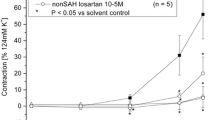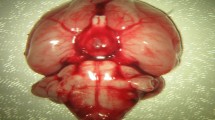Summary
The vasoactive effects of substance P (SP), as well as the content of cyclic guanine monophosphate (cGMP), were determined in the rabbit basilar artery after subarachnoid haemorrhage (SAH).
Out of 47 rabbits, 24 were subjected to a SAH, induced by injecting 5ml of autologous arterial blood into the cisterna magna; 23 were used as controls. In 20 animals (10 SAH and 10 controls), isometric tension recording of isolated rings of the basilar artery — dissected 2 days after SAH — was employed to assess the dosedependent vasodilatation to SP (10−10 to 10−6M) after precontraction with serotonin (10−8 to 10−5M). In 15 animals (8 SAH and 7 controls), the basal cGMP content was measured in the basilar artery 2 days after SAH. In the other 12 animals (6 SAH and 6 controls), the increase in cGMP content was measured in the basilar artery after a 10-minute incubation with SP (10−6M).
SP caused significantly less dilatation in animals subjected to SAH than in controls, especially for concentrations between 10−9 and 10−6M (p < 0.001). The cGMP content in the arteries 2 days after SAH was significantly lower than in control arteries (31.5 ± 7.3 against 57.3 ± 4.3 pmoles/g tissue). In the preparations incubated with SP, the increase of cGMP was 440 ± 115% in the control arteries, and only 97 ± 30% in the arteries after SAH.
It is concluded that the vasodilator activity of SP is significantly impaired after SAH. Moreover, the changes in cGMP content after SAH suggest a link between impaired vasoactive response to SP and decreased production of cGMP after SAH.
Similar content being viewed by others
References
Allen JM, Todd N, Crockard HA, Schon F, Yeats JC, Bloom SR (1984) Presence of neuropeptide Y in human circle of Willis and its possible role in cerebral vasospasm. Lancet 8: 550–552
Clower BR, Yoshioka J, Honma T, Smith RR (1988) Blood platelets and early intimal changes in cerebral arteries following experimental subarachnoid hemorrhage. In: Wilkins RH (ed) Cerebral vasospasm. Raven Press, New York, pp 335–341
Delgado-Zygmunt TJ, Arbab MA, Edvinsson L, Jansen I, Svendgaard NA (1990) Prevention of cerebral vasospasm in the rat by depletion or inhibition of substance P in conducting vessels. J Neurosurg 72: 917–925
Diamond J, Chu EB (1983) Possible role for cyclic GMP in endothelium-dependent relaxation of rabbit aorta by acetylcholine. Comparison with nitroglycerin. Res Commun Chem Pathol Pharmacol 41: 369–381
Edvinsson L, Ekman R, Jansen I, Ottosson A, Uddman R (1987) Peptide-containing nerve fibers in human cerebral arteries: immunocytochemistry, radioimmunoassay, and in vitro pharmacology. Ann Neurol 21: 431–437
Edvinsson L, Fredholm BB, Hamel E, Jansen I, Verrecchia C (1985) Perivascular peptides relax cerebral arteries concomitant with stimulation of cyclic adenosine monophosphate accumulation or release of an endothelium-derived relaxing factor in the cat. Neurosci Lett 58: 213–217
Edvinsson L, McCulloch J, Uddman R (1981) Substance P: immunohistochemical localization and effect upon cat pial arteries in vitro and in situ. J Physiol 318: 251–258
Edvinsson L, Rosendal-Helgesen S, Uddman R (1983) Substance P: localization, concentration and release in cerebral arteries, choroid plexus and dura mater. Cell Tissue Res 234: 1–7
Edvinsson L, Skarby T (1984) Interaction of peptides present in perivascular nerves on the smooth muscle of cat cerebral arteries and on the stimulation-evoked efflux of3H-noradrenaline. J Auton Pharmacol 4: 193–198
Furchgott RF, Cherry PD, Zawadzki JV, Jothianandan D (1984) Endothelial cells as mediators of vasodilation of arteries. J Cardiovasc Pharmacol 6: S336-S343
Furchgott RF, Zawadzki JV (1980) The obligatory role of endothelial cells in the relaxation of arterial smooth muscle by acetylcholine. Nature 288: 373–376
Handa J, Yoneda S, Matsuda M, Handa H (1974) Effects of prostaglandins A1, E1, E2, F2a on the basilar artery of cats. Surg Neurol 2: 251–255
Hara H, Nosko M, Weir B (1986) Cerebral perivascular nerves in subarachnoid hemorrhage. A histochemical and immunohistochemical study. J Neurosurg 65: 531–539
Hara H, Weir B (1987) Different distributions of substance P and vasoactive intestinal polypeptide in the cerebral arterial innervation in rat and guinea pig. Anat Anz 163: 19–23
Holzman A, Gillespie JS (1982) Block of some non-adrenergic inhibitory responses of smooth muscle by a substance from haemolysed erythrocytes. J Physiol (Lond) 328: 11–25
Hongo K, Kassell NF, Nakagomi T, Sasaki T, Tsukahara T, Ogawa H, Vollmer DG, Lehman RM (1988) Subarachnoid hemorrhage inhibition of endothelium-derived relaxing factor in rabbit basilar artery. J Neurosurg 69: 247–253
Hongo K, Tsukahara T, Kassell NF, Ogawa H (1989) Effect of SAH on calcitonin gene-related peptide-induced relaxation in rabbit basilar artery. Stroke 20: 100–104
Ignarro LJ, Burke TM, Wood KS, Wolin MS, Kadowitz PJ (1984) Association between cyclic GMP accumulation and acetylcholine-elicited relaxation of bovine intrapulmonary artery. J Pharmacol Exp Ther 228: 682–690
Kim P, Lorenz RR, Sundt TM, Vanhoutte PM (1989) Release of endothelium-derived relaxing factor after subarachnoid hemorrhage. J Neurosurg 70: 108–114
Kim P, Sundt TM, Vanhoutte PM (1988) Alterations in endothelium-dependent responsiveness of the canine basilar artery after subarachnoid hemorrhage. J Neurosurg 69: 239–246
Liszczak TM, Varsos VG, Black PMcL, Kistler JP, Zervas NT (1983) Cerebral arterial constriction after experimental subarachnoid hemorrhage is associated with blood components within the arterial wall. J Neurosurg 58: 18–26
Liu-Chen LY, Mayberg MR, Moskowitz MA (1983) Immunohistochemical evidence for a substance P-containing trigeminovascular pathway to pial arteries in cats. Brain Res 268: 162–166
Lobato RD, Marin J, Salaices M, Rivilla F, Burgos J (1980) Cerebrovascular reactivity to noradrenaline and serotonin following experimental subarachnoid hemorrhage. J Neurosurg 53: 480–485
Martin W, Furchgott RF, Villani GM, Jothianandan D (1986) Depression of contractile responses in rat aorta by spontaneously released endothelium-derived relaxing factor. J Pharmacol Exp Ther 237: 529–538
Martin W, Villani GM, Jothianandan D, Furchgott RF (1985) Selective blockade of endothelium-dependent and glyceryl trinitrate-induced relaxation by hemoglobin and by methylene blue in the rabbit aorta. J Pharmacol Exp Ther 232: 708–716
Mejia JA, Pernow J, Von Holst H, Rudehill A, Lundberg JM (1988) Effects of neuropeptide Y, calcitonin gene-related peptide, substance P, and capsaicin on cerebral arteries in man and animals. J Neurosurg 69: 913–918
Moskowitz MA, Kuo C, Leeman SE, Jessen ME, Derian CK (1987) Desensitization to substance P-induced vasodilation in vitro is not shared by endogenous tachykinin neurokinin A. J Neurosci 7: 2344–2351
Nakagomi T, Kassell NF, Sasaki T, Fujiwara S, Lehman RM, Torner JC (1987) Impairment of endothelium-dependent vasodilation induced by acetylcholine and adenosine triphosphate following experimental subarachnoid hemorrhage. Stroke 18: 482–489
Norregaard TV, Moskowitz MA (1985) Substance P and the sensory innervation of intracranial and extracranial feline cephalic arteries. Implications for vascular pain mechanisms in man. Brain 108: 517–533
Onoue H, Nakamura N, Toda N (1988) Endothelium-dependent and -independent responses to vasodilators of isolated dog cerebral arteries. Stroke 19: 1388–1394
Onoue H, Nakamura N, Toda N (1989) Prolonged exposure to oxyhemoglobin modifies the response of isolated dog middle cerebral arteries to vasoactive substances. Stroke 20: 657–663
Owman C, Andersson J, Hanko J, Hardebo JE (1984) Neurotransmitter amines and peptides in the Cerebrovascular bed. In: MacKenzie ET, Seylaz J, Bès A (eds) L.E.R.S. Monograph Series, Vol 2. Neurotransmitters and the cerebral circulation. Raven Press, New York, pp 11–36
Palmer RMJ, Ferrige AG, Moncada S (1987) Nitric oxide release accounts for the biological activity of endothelium-derived relaxing factor. Nature 327: 524–526
Pickard JD, Walker V (1984) Current concepts of the role of prostaglandins and other eicosanoids in acute Cerebrovascular disease. In: MacKenzie ET, Seylaz J, Bès A (eds) L.E.R.S. Monograph Series, Vol 2. Neurotransmitters and the cerebral circulation. Raven Press, New York, pp 191–217
Rapoport RM, Murad F (1983) Agonist-induced endothelium dependent relaxation in rat thoracic aorta may be mediated through cGMP. Circ Res 52: 352–357
Sasaki T, Kassell NF, Yamashita M, Fujiwara S, Zuccarello M (1985) Barrier disruption in the major cerebral arteries following experimental subarachnoid hemorrhage. J Neurosurg 63: 433–440
Summers RJ, Molenaar P, Stephenson JA (1987) Autoradiographic localization of receptors in the cardiovascular system. TIPS 8: 272–276
Svendgaard NA, Edvinsson L, Owman C, Sahlin C (1977) Increased sensitivity of the basilar artery to norepinephrine and 5-hydroxytryptamine following experimental subarachnoid hemorrhage. Surg Neurol 8: 191–195
Tani E, Maeda Y (1980) Cyclic nucleotide metabolism in experimental cerebral vasospasm. In: Wilkins RH (ed) Cerebral arterial spasm. Williams and Wilkins, Baltimore London, pp 202–214
Tanishima T (1980) Cerebral vasospasm: contractile activity of hemoglobin in isolated canine basilar arteries. J Neurosurg 53: 787–793
Toda N (1988) Hemolysate inhibits cerebral artery relaxation. J Cereb Blood Flow Metabol 8: 46–53
Toda N, Okamura T (1990) Mechanism underlying the response to vasodilator nerve stimulation in isolated dog and monkey cerebral arteries. Am J Physiol 259: H1511-H1517
Tsukahara T, Hongo K, Kassell NF, Ogawa H (1989) The influence of experimental subarachnoid hemorrhage on the relaxation of the rabbit cerebral arteries induced by vasoactive intestinal polypeptide in the cerebral arteries of the rabbit. Neurosurgery 24: 731–735
Uddman R, Edvinsson L, Ekman R, Kingman T, McCulloch J (1985) Innervation of the feline cerebral vasculature by nerve fibers containing calcitonin gene-related peptide: trigeminal origin and co-existence with substance P. Neurosci Lett 62: 131–136
Uemura Y, Sugimoto T, Okamoto S, Handa H, Mizuno N(1987) Changes of neuropeptide immunoreactivity in cerebrovascular nerve fibers after experimentally produced SAH. Immunohistochemical study in the dog. J Neurosurg 66: 741–747
Wanaka A, Matsuyama T, Yoneda S, Kimura K, Kamada T, Girgis S, MacIntyre I, Emson PC, Tohyama M (1986) Origins and distribution of calcitonin gene-related peptide-containing nerves in the wall of the cerebral arteries of the guinea pig with special reference to the co-existence with substance P. Brain Res 369: 185–192
White RP, Robertson JT (1985) Role of plasmin, thrombin and antithrombin III as etiological factors in delayed cerebral vasospasm. Neurosurgery 16: 27–35
Zuccarello M, Liwnicz B, Keller JT, Tew JM, Jr, Tierney B (1988) Intracisternal synthetic substance P increases vascular permeability. In: Wilkins RH (ed) Cerebral vasospasm. Raven Press, New York, pp 187–193
Author information
Authors and Affiliations
Rights and permissions
About this article
Cite this article
Pasqualin, A., Tsukahara, T., Hongo, K. et al. Cerebrovascular effects of substance P after experimental subarachnoid haemorrhage. Acta neurochir 119, 139–145 (1992). https://doi.org/10.1007/BF01541798
Issue Date:
DOI: https://doi.org/10.1007/BF01541798




